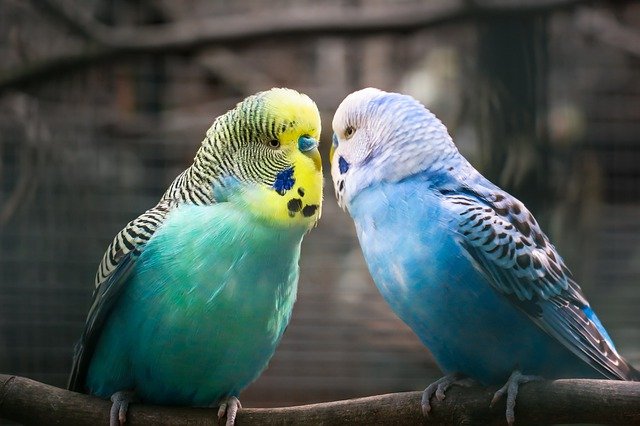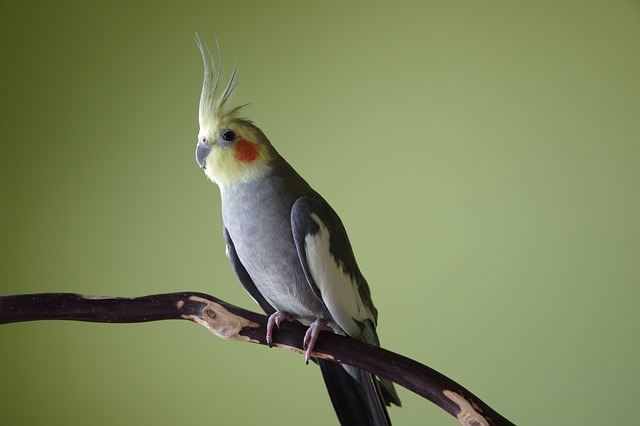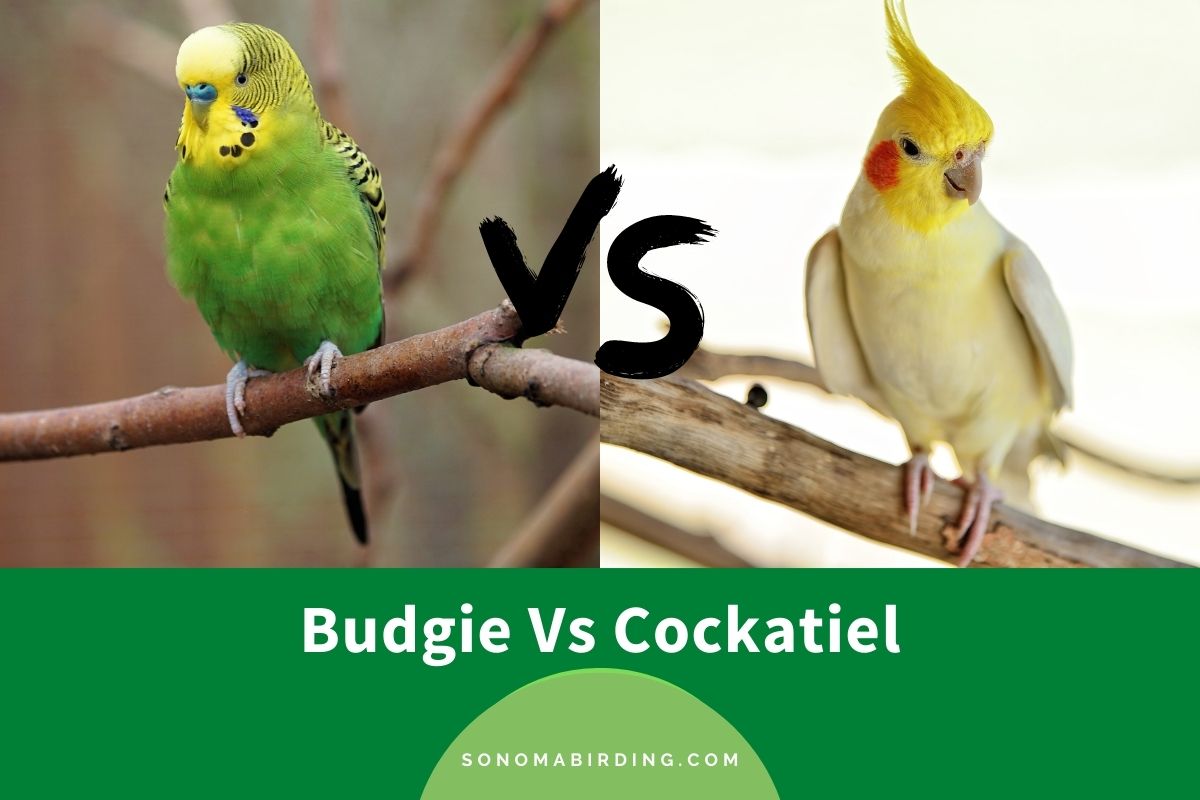Budgies and cockatiels are birds that anyone can fall in love with. They are playful, energetic, and will follow you around the house to say hello. These two types of birds enjoy a similar reputation in many ways; however, there are some major differences between the two that are important to learn before choosing one as your pet bird.
So, what is the difference between a budgie and a cockatiel? Although both budgies and cockatiels are members of the parrot family, cockatiels are much larger than budgies. Cockatiels also exhibit a crest atop their heads that budgies lack. When compared to the cockatiel, the budgie is much more energetic and lively. It can entertain you with its activity all day long! Cockatiels, on the other hand, are only active at certain times of the day.
Both budgies and cockatiels are adorable birds belonging to the parrot family. And while there are some traits the two share, they do have their own differences as well. In this article, we are going to discuss the similarities as well as differences between budgies and cockatiels. We’ll also tell you which one of them can be a better pet for you.
Budgies and Cockatiels: at a glance
Before we delve into discussing the differences and similarities between these two parrots, let’s take a quick look at their basic characteristics.
Budgies are originally named “budgerigar”, and are one of the small members of the parakeet family. Being closely related to the fig parrots and the lories, they are the only species in the Melopsittacus genus.
These birds are a flock of nomadic parakeets that have mastered the art of breeding on the move. Their nomadic lifestyle also helps them to adapt to different climates and habitats, which is another reason they’re the third most popular pet in the world (after cats and dogs).
Also referred to as a “quarrion” or a “weiro bird”, the cockatiels are the smallest species belonging to the cockatoo families. Just like the budgies, cockatiels are the sole member of their genus (Nymphicus) as well.
In fact, as a popular caged bird pet, they rank second, right after the budgies. These birds are endemic to the scrublands and wetlands of Australia.
Check out the table given below, which contains the basic info of both these birds:
| Parameters | Budgie | Cockatiel |
|---|---|---|
| Scientific name | Melopsittacus undulatus | Nymphicus hollandicus |
| Average weight | 30-40 grams | 70-120 grams |
| Average height | 18 centimeters (7 inches) | 30-33 centimeters (12-13 inches) |
| Wingspan | 30 centimeters (12 inches) | 33-36 centimeters (13-14 inches) |
| Lifespan | 5-8 years | 10-14 years |
| Population status | Stable | Stable |
| Trainability | Intelligent and easy to train | Learn things quickly; high trainability |
| Required exercise time | 20-30 minutes | 30-40 minutes |
Appearance
The first ground on which you can differentiate between a budgie and a cockatiel is their appearance. Some might say that the two are similar looking, but upon close examination, you can easily notice how different they are.
What do Budgies look like?

Both sexes of the adult budgies look similar to each other, with only the color of their cere (a soft, fleshy patch present just above their bill) being different. The males have a royal blue cere, whereas the breeding females have a brown cere. The color of the non-breeding females’ ceres ranges between white and pale brown.
The face of the budgies is mostly bright yellow in color, with their underparts (from breast to vent) being colored in light green.
On their face, they have two significant violet cheek patches (one on each side), along with three black throat patches (two of which are located right below each cheek patch). The wings of these birdies are greenish-black in color, with black coverts and yellow fringes that appear when they are in flight.
Their tail is cobalt blue, with their legs colored in blueish-grey. The beak of budgies is olive-grey in color and is surrounded with fluffy feathers, due to which it appears to be facing downwards. As with most parrot species, their upper beak is long and smooth, curving towards the edge, while the lower one is much smaller, almost shaped like a half-sized cup.
The cere of the juvenile budgies (both sexes) is pink until they reach the age of 6 months. However, in some cases, the immature males’ cere might start to develop a slightly purplish shade earlier. Up until 3-4 months, you can also find blackish stripes on their cere.
When bred in captivity, budgies are also born colored in greyish-green, white, and yellowish-blue. However, the most common variation that you can find at any pet store, after their natural yellow-green coloration, is blue.
What do Cockatiels look like?

Despite being the smallest member of their family, cockatiels are still considerably larger than the budgies. The most prominent feature of their appearance, which sets them up apart from budgies and many other parrot species, is the crest located on top of their head.
The position of cockatiels’ crest often expresses their emotional state. When they are happy, excited, or startled, their crest stands straight, pointing upwards. When they’re feeling angry or defensive, their crest lies flattened atop their head. When these birds are trying to attract a mate or flirt with a prospective partner, their crest is flattened but protrudes backward. Lastly, in a calm or neutral state, their crest will be standing obliquely, which is how it is positioned most of the time.
The adult cockatiels display sexual dimorphism to some extent. The males have a white head, with their crest and the area around their beak colored in yellow.
On the other hand, the females have pale grey faces and crests. The females also have tail feathers that are colored in yellow ventrally, which the males lack. Both sexes possess an orange cheek patch on each side of their face, also known as “cheddar cheeks”.
The rest of their body is identical to one another; both have black eyes, greyish beak, and grey legs. Their underbody is covered entirely in light grey, with a slight touch of white on their belly. Their wings are covered in a darker tone of grey, with bold white patches on each side of their flight feathers. The immature cockatiels take after their mothers.
The personality of budgies and cockatiels: similarities and differences
All of us can agree that both budgies and cockatiels are affectionate birds that get attached to their owners in no time. However, these birds do have some differences that might make one of them a better choice for you than the other. Let’s take a look at some common grounds of distinction between these birds:
Budgie or cockatiel: which one is easier to care for?
While both these birds have similar physical health, budgies can be higher maintenance than cockatiels when it comes to their mental well-being. These birds don’t do well in isolation; if you leave them alone for more than a couple of hours at once, they will begin to feel bored.
And in no time, their boredom turns into loneliness and depression. Therefore, if you ever have to leave them alone for more than 2-3 hours, you better plan ahead and add plenty of food and water in the cage. You must also give them several toys to play with, which will keep them entertained while you’re gone.
In comparison, it takes more time for the cockatiels to feel lonely, which means that they’re the ones that are easier to care for.
Budgie or cockatiel: which one is noisier?
Did you know that both budgies and cockatiels are among the quieter parrot species, which makes them perfect pets for people living in apartments? That’s true; if you were planning on getting a pet parrot, you could do a lot worse in terms of noise, such as Conures, Amazon Parrots, or Macaws.
However, when it comes down to comparing these two in terms of the noise they make, we’d have to go with the budgies. Although cockatiels are louder among the two, it is certainly the budgie that tends to be noisy for a longer period.
Unlike the cockatiels that vocalize at a specific time of the day, when the budgies start their chatter, they go on incessantly until they’ve tired themselves. And if you’re keeping more than one budgie at home, you can’t expect to have a moment of peace for yourself.
Pro-tip: Among the sexes of both budgies and cockatiels, the females are generally quieter than the males. So, if you’re looking for a feathered pet that isn’t too vocal, go for the females.
Budgie or cockatiel: which one has a better talking ability?
When it comes to learning to talk, both budgies and cockatiels have more or less the same skill set. Both of them can learn to talk, whistle, and even mimic your speech. Although the time they take to learn might differ from one individual to another, there’s no significant difference between the species.
However, while they both learn at almost the same pace, the cockatiel might not want to engage with you or display their talking skills as often as the budgie. So, if you want a pet you can talk to whenever you feel like, budgies are a better choice for you.
Budgie or cockatiel: which one is more energetic?
As you might have gathered by now, despite their smaller size, budgies are certainly the more energetic species among the two. These little birdies are like firecrackers; they’re loud and active and play and whistle tirelessly all day long. They’re highly social and would want to indulge you every couple of hours.
On the other hand, the cockatiels have a pretty laid-back attitude. As much as they enjoy playing and interacting with you, they do like being by themselves as well. You will often find them sitting quietly, probably busy preening their feathers, looking perfectly content and peaceful.
Budgie or cockatiel: which one is more likely to bite you?
While petting your feathered pets and playing with them can be fun, you wouldn’t want to be bitten by them, would you? Well, then budgies are certainly ideal for you. As noisy as they can be, these birds are very affectionate towards their owners and are also quite gentle in general. The chances of these birdies biting you are very slim.
On the other hand, you cannot be so sure about cockatiels. Although these guys are not outright violent, they can be “moody” at times. For instance, if you’re scratching their necks lovingly and they’re not in a mood for it, they might bite your finger as a warning to stop. If that happens, it is best to back off and give them a little space to calm down.
Budgie or cockatiel: which one would make a better pet for you?
Are you still not sure which bird, out of these two, you should go for? Well, let’s make that choice a little easier on you. While budgies and cockatiels are both great household pets, which one would be better for you depends on your preference.
Are you someone living in a family with kids who have plenty of time to spare on a pet? Then budgies would be ideal for you. These birdies will keep the children engaged and can be quite entertaining.
On the other hand, cockatiels would make better pets for people who have long working hours and spend little time at home. These birds are also ideal for the elderly, who might not be able to engage them but merely seek company.
Can budgies and cockatiels live together?
Yes, they can. These birds do share enough similarities to get along with each other. And in the ways that they’re not similar, they can complement each other. For instance, despite their size, the budgies are the dominating ones out of the two. But the cockatiels, being companion birds, don’t mind it.
However, several factors play a key role in determining whether or not these birds would enjoy living together. First and foremost, making a proper introduction is an essential task on your part. When the two birds are introduced, make sure it’s on neutral ground and not inside one of their cages.
You must also give the new parrot some time to get acquainted with their new home before forcing them to be friends with the other bird. Once the bird is familiar with their surroundings, you can place their cages next to each other and let them build a bond. But if the two do not seem to be getting along well, it is best to keep them apart. Individual difference is also an important factor, one which you can do nothing about.
If both the budgie and cockatiel do get along, it’s great. However, you should never make them share a cage because that often leads to tension and conflict among them.
Do budgies and cockatiels eat the same food?
If you’re planning to get both budgies and cockatiels as pets and are wondering about what to feed them, we have good news for you. Both these birdies can eat the same food. The two have a similar diet in the wild, and would happily eat seeds, veggies, fruits, and other treats. You can purchase a general seed mix to feed them both.
However, some pet parents have claimed that too many sunflower seeds are not good for the budgie’s health. Therefore, get your feathered pets a mix with fewer sunflower seeds, and they will both be healthy and happy.
Conclusion
In this article, we’ve learned that although budgies and cockatiels are parrot species that are popular as household pets, there are several differences in their personality that set them apart. If you want to get one of these little birdies as a pet, go through all of the characteristics mentioned above carefully to make an informed choice.

